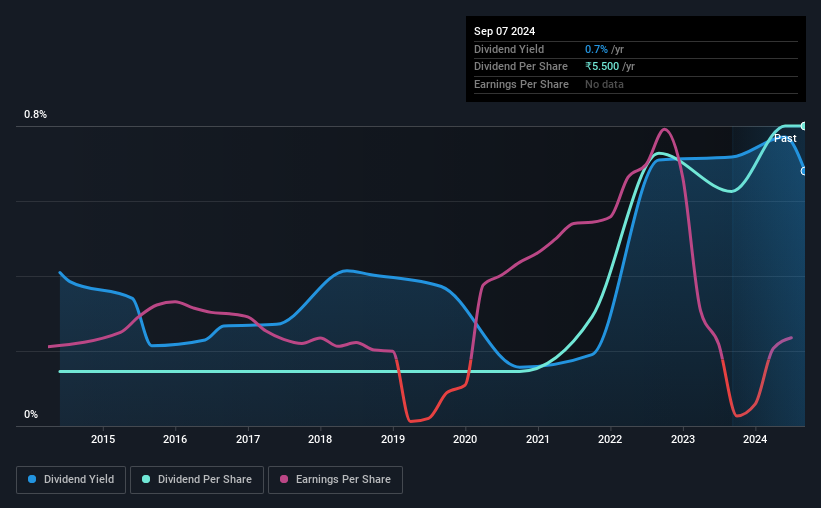Jindal Poly Films (NSE:JINDALPOLY) Is Paying Out A Larger Dividend Than Last Year
Jindal Poly Films Limited (NSE:JINDALPOLY) will increase its dividend from last year's comparable payment on the 30th of October to ₹5.50. The payment will take the dividend yield to 0.7%, which is in line with the average for the industry.
While the dividend yield is important for income investors, it is also important to consider any large share price moves, as this will generally outweigh any gains from distributions. Investors will be pleased to see that Jindal Poly Films' stock price has increased by 58% in the last 3 months, which is good for shareholders and can also explain a decrease in the dividend yield.
Check out our latest analysis for Jindal Poly Films
Jindal Poly Films' Payment Could Potentially Have Solid Earnings Coverage
We like a dividend to be consistent over the long term, so checking whether it is sustainable is important. Jindal Poly Films is quite easily earning enough to cover the dividend, however it is being let down by weak cash flows. We think that cash flows should take priority over earnings, so this is definitely a worry for the dividend going forward.
Over the next year, EPS could expand by 1.5% if recent trends continue. Assuming the dividend continues along recent trends, we think the payout ratio could be 21% by next year, which is in a pretty sustainable range.

Jindal Poly Films Has A Solid Track Record
The company has an extended history of paying stable dividends. The annual payment during the last 10 years was ₹1.00 in 2014, and the most recent fiscal year payment was ₹5.50. This means that it has been growing its distributions at 19% per annum over that time. Rapidly growing dividends for a long time is a very valuable feature for an income stock.
The Dividend's Growth Prospects Are Limited
Investors could be attracted to the stock based on the quality of its payment history. However, Jindal Poly Films' EPS was effectively flat over the past five years, which could stop the company from paying more every year. While EPS growth is quite low, Jindal Poly Films has the option to increase the payout ratio to return more cash to shareholders.
Our Thoughts On Jindal Poly Films' Dividend
Overall, we always like to see the dividend being raised, but we don't think Jindal Poly Films will make a great income stock. With cash flows lacking, it is difficult to see how the company can sustain a dividend payment. This company is not in the top tier of income providing stocks.
Market movements attest to how highly valued a consistent dividend policy is compared to one which is more unpredictable. Meanwhile, despite the importance of dividend payments, they are not the only factors our readers should know when assessing a company. For example, we've picked out 3 warning signs for Jindal Poly Films that investors should know about before committing capital to this stock. Looking for more high-yielding dividend ideas? Try our collection of strong dividend payers.
New: Manage All Your Stock Portfolios in One Place
We've created the ultimate portfolio companion for stock investors, and it's free.
• Connect an unlimited number of Portfolios and see your total in one currency
• Be alerted to new Warning Signs or Risks via email or mobile
• Track the Fair Value of your stocks
Have feedback on this article? Concerned about the content? Get in touch with us directly. Alternatively, email editorial-team (at) simplywallst.com.
This article by Simply Wall St is general in nature. We provide commentary based on historical data and analyst forecasts only using an unbiased methodology and our articles are not intended to be financial advice. It does not constitute a recommendation to buy or sell any stock, and does not take account of your objectives, or your financial situation. We aim to bring you long-term focused analysis driven by fundamental data. Note that our analysis may not factor in the latest price-sensitive company announcements or qualitative material. Simply Wall St has no position in any stocks mentioned.
About NSEI:JINDALPOLY
Jindal Poly Films
Manufactures and sells biaxially oriented polyethylene terephthalate (BOPET) films, and BOPP films in India and internationally.
Average dividend payer with mediocre balance sheet.
Similar Companies
Market Insights
Weekly Picks


Crazy Undervalued 42 Baggers Silver Play (Active & Running Mine)


Fiducian: Compliance Clouds or Value Opportunity?

Willamette Valley Vineyards (WVVI): Not-So-Great Value
Recently Updated Narratives

TXT will see revenue grow 26% with a profit margin boost of almost 40%

Significantly undervalued gold explorer in Timmins, finally getting traction

Moderation and Stabilisation: HOLD: Fair Price based on a 4-year Cycle is $12.08
Popular Narratives


MicroVision will explode future revenue by 380.37% with a vision towards success


NVDA: Expanding AI Demand Will Drive Major Data Center Investments Through 2026





